
| CONTENT - The IR Hubble Ultra Deep Field (HUDF) as seen by December 2009, the farthest view of the Universe ever |
As it had imaged the Hubble Deep Field has been taken by 1995 and two years later a similar view in the southern sky, the Hubble Deep Field South, the Hubble Space Telescope, by December 2009, has made the deepest image of the Universe ever taken, in near-infrared light. The faintest and reddest objects in the image are galaxies that formed 600 million years after the Big Bang only. The new deep view also provides insights into how galaxies grew in their formative years early in the Universe's history. The field is minute and in the constellation Fornax, the Furnace, a southern constellation
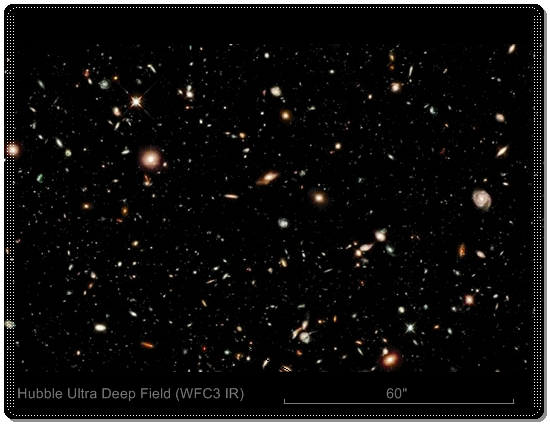 | The IR Hubble Ultra Deep Field (December 2009). picture site 'Amateur Astronomy' from a picture NASA/ESA/S. Wyithe (University of Melbourne), H. Yan (Ohio State University), R. Windhorst (Arizona State University), and S. Mao (Jodrell Bank Center for Astrophysics, and National Astronomical Observatories of China) |
Hubble, by 2004, already had taken in the same region the Hubble Ultra Deep Field (HUDF) in the visible-light. Hubble's newly installed Wide Field Camera 3 (WFC3) which allowed to the new picture, collects light from near-infrared wavelengths and therefore looks even deeper into the Universe, because the light from very distant galaxies is stretched out of the ultraviolet and visible regions of the spectrum into near-infrared wavelengths by the expansion of the Universe. The colors in the image are assigned comparatively short, medium, and long, near-IR wavelengths (blue, 1.05 microns; green, 1.25 microns; red, 1.6 microns). The representation is "natural" in that blue objects look blue and red objects look red. The faintest objects are about one billionth as bright as can be seen with the naked eye. Hubble's successor, the James Webb Space Telescope (JWST), will look even farther into the Universe than Hubble, at infrared wavelengths, planned to launch in 2014. Numerous, faint, galaxies in the field appear through strong gravitational lensing by foreground objects as about 20 to 30 percent of these high, z~8 or more redshift galaxies are thus very close to foreground galaxies
A object detected with the Wide Field Camera 3 starting just a few months after it was installed at the telescope by last servicing mission in May 2009 and then confirmed after more than a year of detailed observations and analysis and identified in the Hubble Ultra Deep Field-Infrared data, is the farthest galaxy seen so far in the Universe, a compact, 1 hundredth the size of our Milky Way Galaxy, galaxy of blue stars which is extant already 480 million years after the Big Bang occurred, or 13.2 billion years ago! The Universe is only 500 million older than that. The proto-galaxy is only visible at the farthest infrared wavelengths observable by Hubble. The object appears as a faint dot of starlight in the Hubble exposures. It is too young and too small to have the familiar spiral shape that is characteristic of galaxies in the local universe. That compact galaxy of hot stars is supposed to have formed more than 100 to 200 million years earlier from gas trapped in a pocket of dark matter
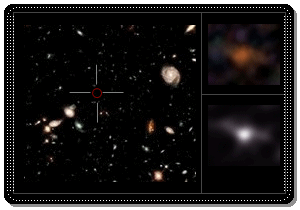 | That image is showing UDFj-39546284, the farthest galaxy ever seen in the distant Universe, with the field left (which is located to the right of the image above), and two detailed views of the galaxy, right. picture site 'Amateur Astronomy', from a picture NASA, ESA, G. Illingworth (University of California, Santa Cruz), R. Bouwens (University of California, Santa Cruz, and Leiden University), and the HUDF09 Team |
A composite Ultra Deep Field has been completed by June 2011 between a image from the Chandra X-ray Observatory and the Hubble Space Telescope (HST), combining the deepest X-ray, optical and infrared views of the sky. The following image is known as the Chandra Deep Field South (CDFS). The composite only shows a small section of the CDFS, where the Chandra sources are blue, the optical HST data are shown in green and blue, and the infrared data from Hubble are in red and green. Chandra also had yielded previously a 'Chandra Deep Field North', a second ultra- deep Chandra field in a different part of the sky
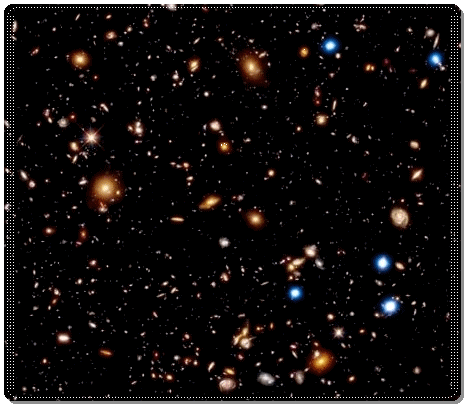 | A part of the Chandra Deep Field South (CDFS) (June 2011). picture site 'Amateur Astronomy' from a picture: X-ray: NASA/CXC/U.Hawaii/E.Treister et al; Infrared: NASA/STScI/UC Santa Cruz/G.Illingworth et al; Optical: NASA/STScI/S.Beckwith et al |
By 2012, the Hubble further took the 'eXtreme Deep Field,' or XDF, a image of a small area of space in the southern constellation Fornax, created using 10 years of Hubble data, making it the deepest image of the Universe ever taken. That image is about the same region than the ones above. The XDF reveals galaxies that span back 13.2 billion years in time. The XDF also will serve next NASA's major space telescope the Webb Telescope, in the infrared, like the place to peer into to look for even fainter galaxies
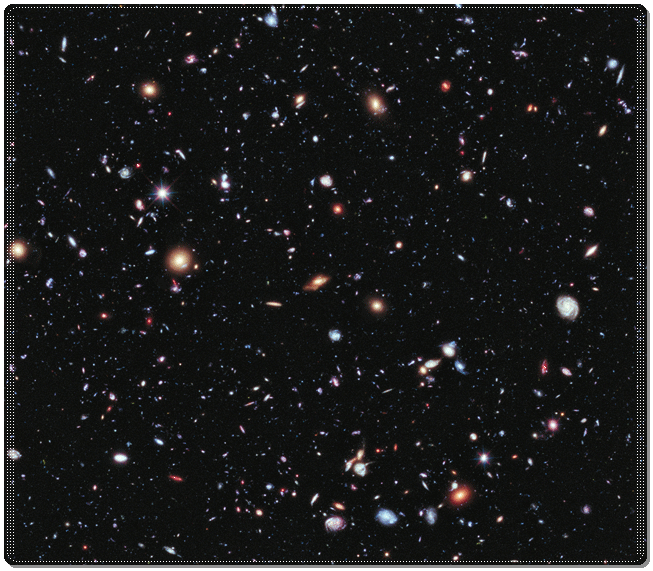 | Hubble's eXtreme Deep Field (XDF) (October 2012). picture site 'Amateur Astronomy' from a picture NASA; ESA; G. Illingworth, D. Magee, and P. Oesch, University of California, Santa Cruz; R. Bouwens, Leiden University; and the HUDF09 Team |
By late 2012, the Hubble Ultra Deep Field (HUDF) 2012 campaign (or UDF12) reached to a previously unseen population of seven faraway galaxies, which are observed as they appeared in a period 350 million to 600 million years after the Big Bang only. Those are the deepest images to date from the Hubble Space Telescope. Those galaxies were revealed from a intensively studied patch of sky known as the Ultra Deep Field (UDF). Astronomers study the distant Universe in near-infrared light because the expansion of space stretches ultraviolet and visible light from galaxies into infrared wavelengths, a phenomenon called redshift. Galaxies seen so date back to the early reionization epoch when first objects in the Universe making the Universe transparent to light, allowing astronomers to look far back into time. The farthest galaxy observed had a redshift of 11.9
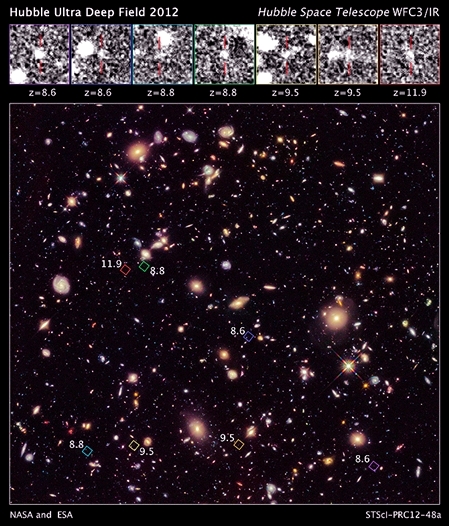 | Hubble's Ultra Deep Field (HUDF) 2012 campaign (or UDF12) (late 2012); the picture matches the lower right three-fourth quarter of the previous image (as it is inversed). picture site 'Amateur Astronomy' from a picture NASA, ESA, R. Ellis (Caltech), and the UDF 2012 Team |
By 2014, the Hubble added to the study, with the 'Ultraviolet Coverage of the Hubble Ultra Deep Field,' stretching all the way from ultraviolet to near-infrared light to within a few hundred million years of the Big Bang and allowing study of star formation in galaxies located from about 5 to 10 billion light-years. A still weaker field, in the frame of the Hubble's Hubble Frontier Fields program, was observed by the Hubble in 2015 through the gravitational lensing of 3 galaxies clusters as it is showing galaxies located at 600 million years after the Big Bang. They likely are the first generation galaxies in the Universe and the weakest ever observed. The joint NASA's Spitzer, Hubble and Chandra Frontier Fields project yieldied for the tiniest, dimmest objects, many of which should prove to be the most distant galaxies ever glimpsed, the record holder lying at 13.4 billion light-years! The 'Ultraviolet Coverage of the Hubble Ultra Deep Field' was followed by Hubble's multi-wavelength data in the CANDELS-Deep ('Cosmic Assembly Near-infrared Deep Extragalactic Legacy Survey') fields, themselves within the central part of the GOODS ('Great Observatories Origins Deep Survey') fields. The 'Hubble Deep UV (HDUV) Legacy Survey,' in the ultraviolet, encompasses 12,000 star-forming galaxies in a part of the constellation Fornax known as the 'GOODS-South field,' straddling the gap between the very distant galaxies, which can only be viewed in infrared light, and closer galaxies, which can be seen across different wavelengths. In the first in a series of Hubble Legacy Field images, a first deep-sky mosaic is showing 265,000 galaxies that stretch back through 13.3 billion years of time to just 500 million years after the Big Bang. That wider view contains about 30 times as many galaxies as in the previous deep field
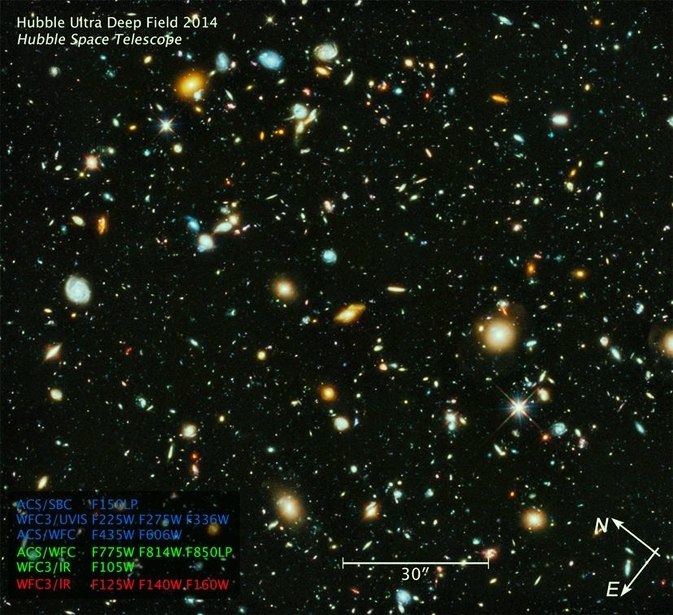 | Ultraviolet Coverage of the Hubble Ultra Deep Field in 2014 stretching from the ultraviolet to the near-infrared. picture site 'Amateur Astronomy' from a picture NASA |